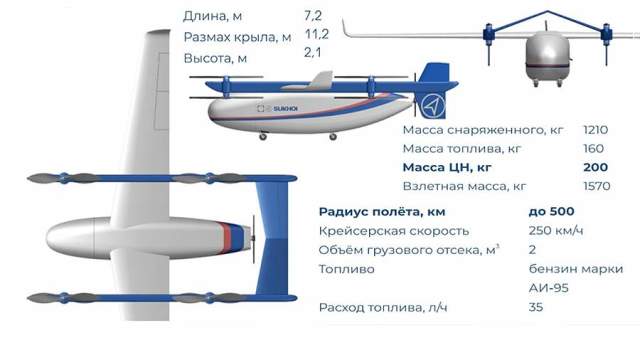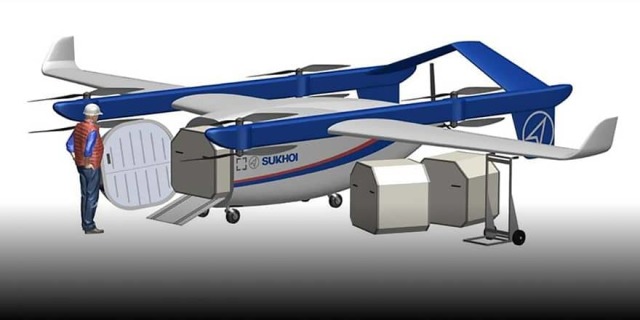Specialists from the Sukhoi Design Bureau have started assembling the Atlas unmanned aerial vehicle. It can take off and land like a helicopter. It is assumed that the drone will help dramatically reduce the price of cargo delivery.
Izvestia reported about the beginning of the assembly of the prototype of the Atlas unmanned vehicle. The UAV is created by the Sukhoi company and specialists from MIPT (Moscow Institute of Physics and Technology). It does not require an airfield: the UAV is able to take off and land vertically. At the same time, he will get a longer flight range.
The device has a length of more than seven meters and a wingspan of over eleven meters. Vertical movement will be provided by electric motors, and it will move horizontally thanks to a gasoline engine.
Eight take-off propellers will lift the device to the desired height, then a pushing screw will come into play. To achieve the necessary characteristics, the creators decided to connect lithium-ion batteries with supercapacitors.

Atlas
Image Source: Dry
The cruising speed of the drone will be 250 kilometers per hour, and the payload capacity will exceed 200 kilograms. The volume of the Atlas cargo compartment is two cubic meters. Together with fuel and cargo, the UAV will have a take-off weight of over 1.5 tons.
Atlas is seen as fully automatic. The operator only needs to specify the destination, and the UAV will cope with the rest of the tasks on its own. If one or another system fails, the operator will be able to indicate the place where the device should sit. It will be possible to operate and maintain Atlas with the help of one technician: thanks to this, they want to reduce the cost of cargo delivery by 40%.
The prototype, which is being assembled by engineers of the Sukhoi Design Bureau, is going to be used for testing vertical takeoff and landing. The transition from vertical to horizontal mode will be worked out later.
Recall that Airbus recently tested the Do-DT25 unmanned aerial vehicle by launching from the A400M military transport aircraft. The tests became part of a program known as the Future Combat Air System (FCAS). As part of it, they want to create a whole family of manned, optionally manned and unmanned vehicles that will become the basis of the European security system in the future.
Last year, the US actively tested a similar system. As it became known in November, the Americans successfully "captured" the X-61 Gremlins unmanned vehicle using a carrier created on the basis of the Lockheed Martin C-130 aircraft. Americans have made such attempts before, but they were unsuccessful.

